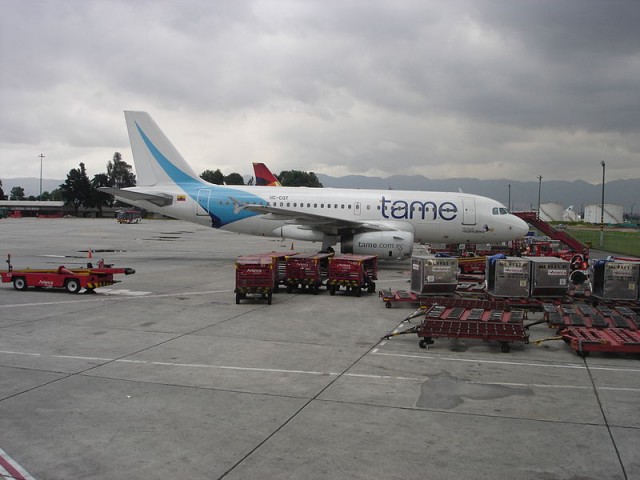
Tame Airlines Airbus A319. Image Sylvain2803 / Wikipedia / CC.
Tame Airlines (or TAME or tame) is the flag carrier of Ecuador and was founded in 1962. The airline mostly serves Ecuador, but also offers flights to Colombia, Panama, Venezuela and seasonally to Cuba.
Tame’s previously livery was unique and I have to admit better — almost. The biggest mistake with the old livery was keeping the nose cap white. Paint it to match the rest of the aircraft and you have yourself a livery that people will remember. Not to say that the new, almost all white, livery is bad, just not original, since many designs today contain too much white.
The airline has put in quite a bit of effort updating their fleet (they ran 727’s as recently as 2009) and they currently operate a fleet of 15 aircraft including the Airbus A319, A320, ATR 42-500, Embraer E170 and E190.
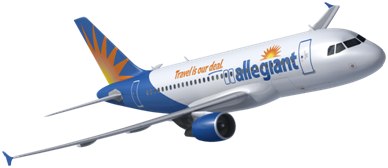
What Allegiant’s Airbus A319s will look like. Image from Allegiant.
Today, Allegiant Air has announced that they plan to add 19 Airbus A319s into their fleet.
Allegiant will lease nine A319’s from GE Capital Aviation Services (GECAS) and also lease 10 A319s from Cebu Pacific Air. The first two A319s are expected to start service during the second quarter of 2013.
The aircraft, which will be configured with 156 economy class seats, will not be new and aged seven to ten years old at the time of delivery.
Can Allegiant’s success of a one model fleet, still exist with a fleet of three different aircraft types? Traditionally, Allegiant only flew MD-80 aircraft and more recently added the 757-200. Now, with a third aircraft type, that greatly increases training and maintenance costs. In a presentation given today, Allegiant stated that, “Pilot transition/training -less efficient, but manageable,” and that “Economics dictate this added complexity is worthwhile.”
“The A319 is a new aircraft type for Allegiant, but we otherwise see this as a continuation of our existing business model,” said Andrew C. Levy, Allegiant President. “A319 asset values have significantly declined and now mirror the environment we saw when we first began buying MD-80s.”
Allegiant is hoping to place the A319s on routes that are just marginally profitable for the MD-80 aircraft. The A319 is 25% cheaper per block hour with fuel and 40% lower on maintenance than the MD-80 aircraft. Also, the range of the A319 is greater with a 3,600 nm vs just 1400 nm, allowing Allegiant to look at longer route opportunities. At this time, the airline is not planning on increasing fleet utilization.
The airline is planning to retire two MD-80s, which have heavy maintenance checks coming up, but do not have future retirement plans at this time. By 2015, Allegiant is planning to be operating 56 MD-80s (58 now), six Boeing 757s (four now) and 19 Airbus A319s (0 now).
Buying the A319 is not a fleeting changing plan, but a fleet growth plan. There is no question that Allegiant got a great deal on the A319, since multiple airlines are dumping that smaller model for larger A320 and A321 aircraft. Soon, there will be more A320CEOs in the market, as airlines upgrade to the A320NEO family.
I would not be surprised to see additional A320 family of aircraft join Allegiant’s fleet before 2015. There will be a lot of change with the airline in the next coming years that will test their ability to succeed. I have a feeling that with the demand for rock bottom airfares increasing, they might be able to pull this off.
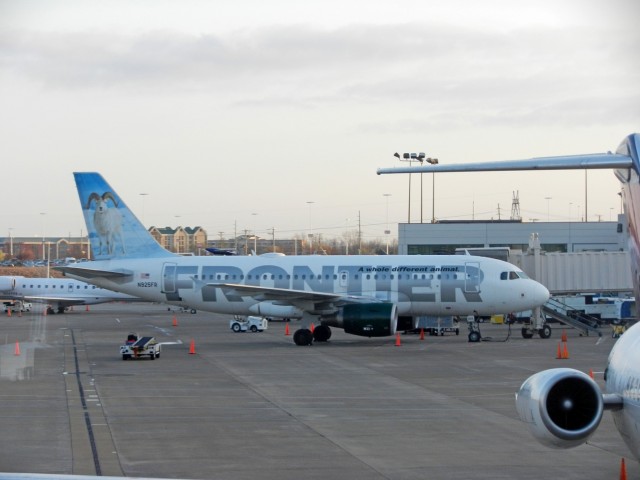
An Airbus 319 in Nashville giving new meaning to the term ’œRam Jet’. Photo by Andrew Vane.
This week’s airline livery comes from Drew Vane. Here is his story in his own words:
If ever there was an airline livery for animal lovers, it’s Frontier Airlines. If you’ve happened to fly anyplace west of the Mississippi, chances are you’ve seen the wildlife friendly tails.
Every since Frontier Airlines announced the “new” re-branded name after merging with Midwest, the airline has continued to wow passengers with their tails, even if the animals painted on them don’t always have them. Not only are these aircraft beautiful works of art, they’re also all unique to each individual aircraft. Be it a regional jet or turboprop flying under Frontier Express or an Airbus A320 series for the main airline, Frontier has as many liveries as it does aircraft. I suppose you could say its got more liveries than any other airline. They even recently had a voting option for the next tail animal with Polly the Parrot pulling in 39% of the vote.
As a wholly owned subsidiary of Indianapolis based Republic Airways Holdings, Frontier Airlines has rapidly grown in its 18 year history to reach 80 destinations from its hubs in Denver, Milwaukee and Kansas City.
I haven’t had the privilege of flying on Frontier but I did catch a glimpse of some of their fleet in Nashville last month. Airline Reporter featured both the Fox and Bald Eagle in past stories. I think they should do away with the traditional N registration numbers mandated by the FAA and register their aircraft with the mascot’s name. I can just hear the pilots on the radio: ’œFrontier Polly want an approach cracker.’
How many animals have you flown on and what are your thoughts on this livery?
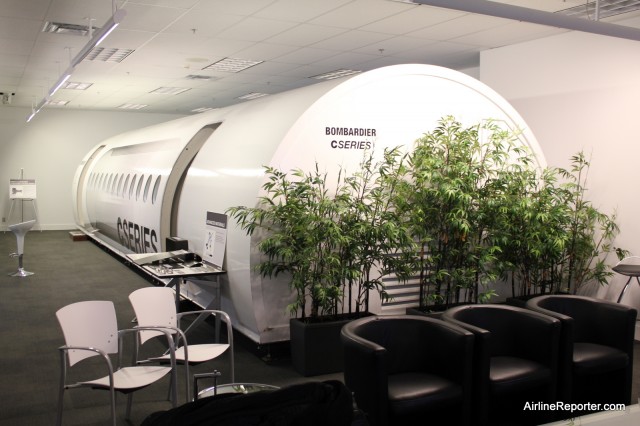
Bombardier's Cseries located in Montreal, Quebec -- tres bon!
After spending the day with Bombardier recently to learn about their new CSeries, the biggest thing I pulled away that you, the passenger will care the most about is SPACE — lots of it. This is the interior that many passengers have been begging for and they are finally going to get it. All the time , I hear people asking for wider seats, more room, etc. But really, what airline is going to take a Boeing 737 or Airbus A320 and go from six seats across to five? (hint: none). The CSeries is designed to provide that extra space that passengers want, but not the additional weight that costs the airlines more money. Bombardier has built enough width into their new CSeries to give passengers extra room, but not enough for airlines to fit in additional seats.
The cabin of the CSeries is set up in a 2-3 layout for economy and 2-2 layout for first class. Personally, I have always loved this layout on the DC-9/MD-80/Boeing 717 aircraft. If you are flying with someone, it gives you the chance for you two to sit together on the two side and not be bothered by a third person. A big downside of those older aircraft was the noise level in the back of the plane from the engines being rear mounted. That won’t be a problem with the CSeries, since the engines are wing-mounted.
Some readers on my Facebook pointed out that having a wider seat is not something new. Piedmont Airlines did it, but it surely has been a long while and really this comes from the design of the aircraft, not from an airline deciding to make the middle seat wider.
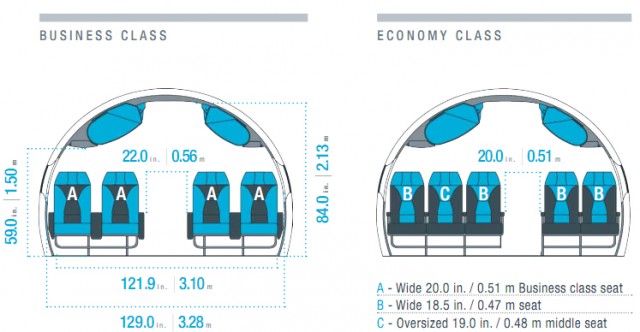
There is plenty of width in the new Bombardier CSeries. Image from Bombardier.
The interior is designed so that most economy seats have 18.5″ width — except the middle seat which is 19″. Now, this just blew my mind… the middle seat is actually 1/2″ wider than the other seats on the plane. How genius is that? Not only that, but a standard 18.5″ width for a short haul seat is great. Many airlines run wide-body, long haul flights with only 18″ or even 17″.
Now, I know what you are all thinking, “Yea right. Bombardier might design the aircraft with space, but airlines will find ways to use that space to fit in as many seats as possible.” Well, do not worry, that will not be the case. First off, there is about half a seat width (from an average aircraft) of extra space built into the plane. If you do the math and an airline puts the aisle to 18″, that would mean each seat would be 15.8″ and that just is not going to happen. Plus, the plane is designed to hold so many passengers with the emergency exits given, so even if an airline made impossibly thin seats, most of them would have to remain empty.
Although seat width will be pretty standard, airlines will have choice with what seat pitch they want to offer. The CSeries mock up in Montreal has the rows set up with different examples from 32″ to 28″. Let me say that at 6’1″, I really hope no airline opts for the 28″ seat pitch on any airplane — ever.
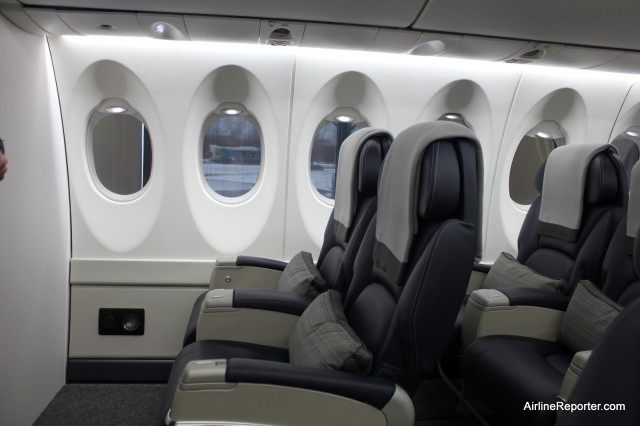
The windows are quite large on the new CSeries, providing more natural light and shoulder room.
The CSeries will sport larger windows than its competition, allowing more natural light and a bit more shoulder room. The CSeries will have windows measuring 11×16″, which are about the size you would find on a Boeing 777.
If you choose a window seat, rest assured, you will actually get a window. How annoying is it to get to your window seat and see a solid wall with no window? Bombardier designed the CSeries so that each row would have at least one window. Not only does this provide great spotting opportunities, it also allows more natural light into the cabin.
At this point, it appears that each window will have a traditional sun shade and not the electronic ones found on the 787 Dreamliner. The reason is this is a smaller aircraft, running shorter hops than the 787 and the extra cost really did not make sense. Like the Dreamliner, the CSeries will also have LED lighting that can change color based on what the airline customer might want.
The aircraft is set to compete directly with the Airbus A318 and A319, the Boeing 737-600 / 737-700, and the Embraer E-195. Bombardier is also hoping those airlines that operate DC-9s and MD-80 aircraft (I am talking to you American and Delta Air Lines) might want to update their fleet with the CSeries.
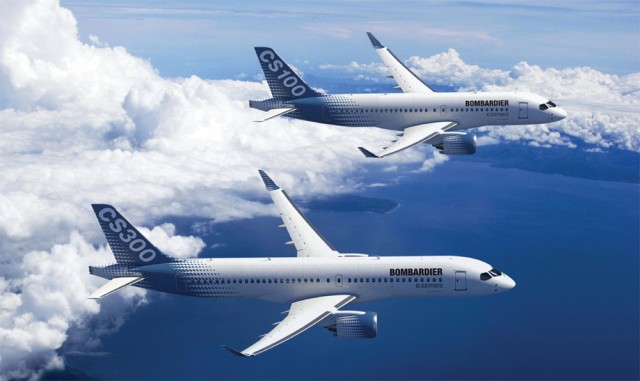
A look at the CSeries 100 and CSeries 300 in this computer mock up from Bombardier.
When designing the CSeries, Bombardier decided to use an aluminum alloy for the fuselage and composite wings. “For the fuselage we performed trade-off analyses, involving airlines in the process, between composite and advanced aluminum design options,” Sebastien Mullot, CSeries Program Director at Bombardier, explained to AirlineReporter.com. “It turned out that the weight gain in the composite option was not as important as in other composite parts (e.g wing) and airlines drew our attention to the fact that this weight gain might be offset by the additional costs that could be incurred on the maintenance side.”
Since the CSeries will be a high-cycle aircraft, there is a much higher chance that the aircraft will be damaged during normal operations. Currently, repairing composite aircraft requires special equipment and procedures, which would have increased operational costs and complexity for airlines. The aluminum alloy used on the CSeries is a aluminum-lithium hybrid that is lighter than traditional aluminum and still can be repaired easily. For now, it seemed to be a perfect fit for what the CSeries will be doing.
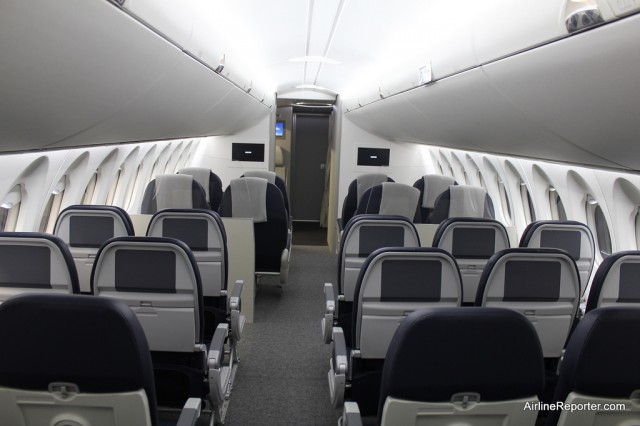
The mock up for the CSeries has different seat pitches for each row. You can see that some have fake entertainment screens as well.
Bombardier is confident that the CSeries will have its first flight before the end of the year. When I asked about potential delays, they stated that they had built-in time for potential delays and unlike other aircraft manufacturers, they have been outsourcing part of their aircraft production for a very long time and are well experienced. They have already been able to work out the kinks and problems from experiences learned with previous aircraft and have not seen the issues that other companies have (ie Boeing and Airbus).
The company hopes that the CSeries will be a complete package for airlines, passengers, crew and the environment. “In an challenging economic environment, airlines have been seeking to grow their average aircraft size in a race to improve their cost efficiency,” Mullot explained. “This aircraft will also be the only single-aisle aircraft to meet 21st century operating requirements: improving flight crew situational awareness, meeting new air traffic control needs and dramatically reducing airlines’ environmental footprint!”
One interesting fact is that we do not know who the launch customer for the CSeries will be. That customer has asked to remain secret and Bombardier is not talking. I am hoping it will be a game changer like Southwest, Ryanair or EasyJet who all operate single aircraft type, but it likely will not be that exciting.
OTHER CSERIES STUFF YOU MUST CHECK OUT:
* All 17 photos of the CSeries mockup in Montreal
* Video of the second mock up by Simpliflying
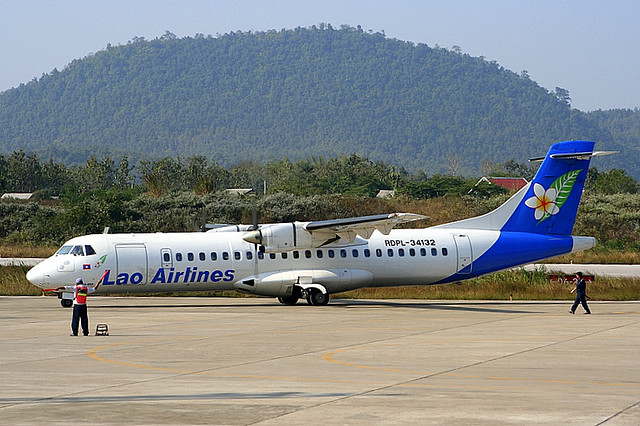
Lao Airlines ATR 72
Lao Airlines was founded in 1976 when Royal Air Lao and Lao Air Lines were merged. At that time, the new airline was known as the Civil Aviation Company. In 1979 the airline’s name was changed to Lao Aviation and retained that name until more recently when it was formally changed to Lao Airlines. The company is based at Wattay International Airport in Vientian, Laos and is fully owned by the Laos government.
The airline operates four ATR-72-500s and four Xian MA60 aircraft. Lao Airlines previously operated an Airbus A320 from 2003 to 2005 and now plans to take delivery of an Airbus A319 in November to start flights to Singapore.
The livery is simple and works. Although many airlines wear flowers on the tail, this livery has a blue background and titles clearly on the front of the aircraft. The livery looks a bit plain on the larger A320, but might work better on the smaller A319.
Image: Shmat








